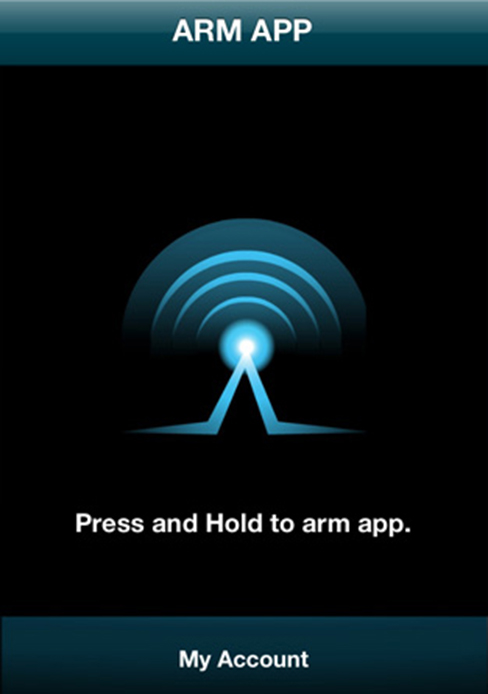
A screenshot from LifeLine Response EDU, a personal safety mobile app.
Credit: Courtesy of LifeLine Response
The trial period for Ohio State students to test run LifeLine Response EDU, a personal safety mobile app, as a part of an Undergraduate Student Government program started Monday. The cost of the USG deal is confidential and the 500 spots open for the pilot program had not yet been filled as of Monday night, according to a USG member.
“LifeLine Response is a phone application that works like a campus blue light on your phone,” said USG senior adviser Matt Deptola, a fourth-year in public affairs. “The application has two modes. It has your thumb mode, which is your active mode, which most people will use and it has your timer mode.”
The LifeLine Response app costs $8.99 on iTunes with a $7.99 cost for a one-year subscription of the service.
The final cost of the deal USG and LifeLine EDU have worked out for the pilot program is confidential because of “the deal we received compared to that of the other schools,” Deptola said.
In the thumb mode, the user presses his or her thumb on the screen of their iPhone or Android. If his or her thumb is released from the screen for 13 seconds, according to the USG website, an alarm sounds and the app prompts for a four-digit passcode, Deptola said.
Users then either enter a code to disarm the alarm or an emergency passcode, Deptola said.
If an emergency passcode is entered, LifeLine EDU call center will call the phone and ensure an emergency is taking place before dispatching help, Deptola said.
If neither passcode is entered, emergency services will use the phone’s GPS location to find the user, while LifeLine EDU texts and emails three preset emergency contacts, including a map of the phone’s location with the messages, Deptola said.
The timer mode is meant for activities like jogging or doing something for an extended period of time where the user can’t hold his or her finger on the phone. After the preset amount of time runs out, the alarm goes off and the user is prompted to enter either the emergency passcode or the disarming code.
The LifeLine EDU pilot program was not in response to any demands for increased safety measures but was an idea some USG members felt would work well at OSU, USG Vice President Josh Ahart said.
“We are always looking for ways to expand safety off-campus. That is one of the most important things we do,” said Ahart, a fourth-year in public affairs. “Safety is always a priority, and we always want to make sure students feel safe off-campus, on-campus and anywhere else they go in the university area. Anything that we can do to enhance that is a step in the right direction to improving safety.”
USG reached out to different organizations and committees in order to recruit a diverse group of 500 participants for the LifeLine EDU pilot program, Deptola said.
“We have a predetermined ratio of students and faculty that we are using, but because we are the Undergraduate Student Government, we are focusing mainly on students living on- and off-campus,” Deptola said. “However, we also have a small portion of the 500 applications for faculty and staff that want to take part.”
As of Monday night, the 500 spots had not yet been filled and USG was still accepting applications, Deptola said.
Some OSU students said the LifeLine EDU pilot program will help increase safety in the campus area.
“I believe that this app will help increase safety more for students that live off-campus,” said Sam Palumbo, a second-year in biology and a smartphone owner. “I have been to a lot of places downtown and off-campus that may be more dangerous, so I think that application would be a good idea.”
Palumbo added the app would be particularly useful in situations where students are unfamiliar with their surroundings.
“Last year me and a lot of friends would take the bus downtown and sometimes get lost and have to get off the bus,” Palumbo said. “I think the application would be good to have in those situations.”
Other students think the app may end up answering to some situations that aren’t emergencies, though.
“While I think there may be a lot of false alarms with this application, I believe in the end, this application will do a lot of good,” said Nicholas Niedermeier, a second-year in international studies who does not own a smartphone.
USG has been negotiating with LifeLine EDU since August 2012 in order to reach a deal to provide the application to students, Deptola said.
The LifeLine EDU program has been tried at smaller universities including University of Toledo and Indiana Wesleyan University, but Deptola said OSU will be one of the largest schools to pilot this program.
Ahart said the purpose of the pilot is to test the app’s capabilities.
“The reason why we are doing a pilot program is because we would like to make sure the app works with a larger number of students,” Ahart said. “We want to make sure it works efficiently, and see whether it makes a difference to how students feel when they are walking home, or anywhere else on campus.”
USG would be interested in expanding the LifeLine EDU program for next year if they receive positive feedback from students and faculty, Deptola said.
“The biggest concern for us is to make sure we are making the application available to as many people as possible at the lowest price,” Deptola said. “If we could subsidize the application and make it available for two or three dollars, or even provide it for free, that would be ideal.”


